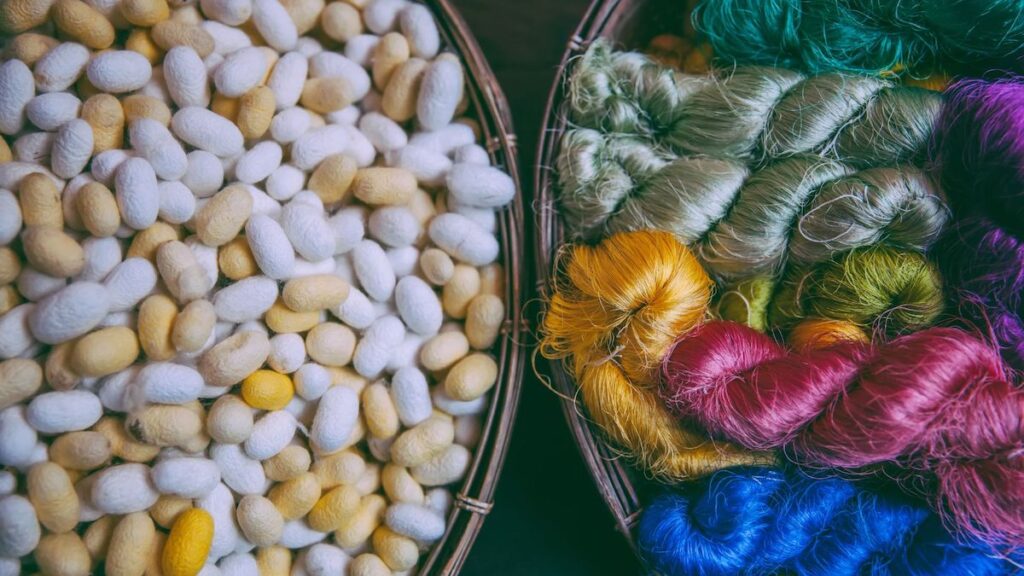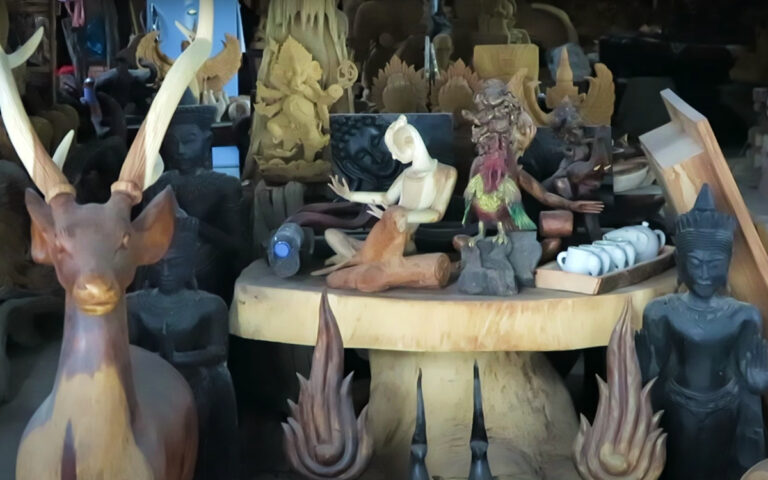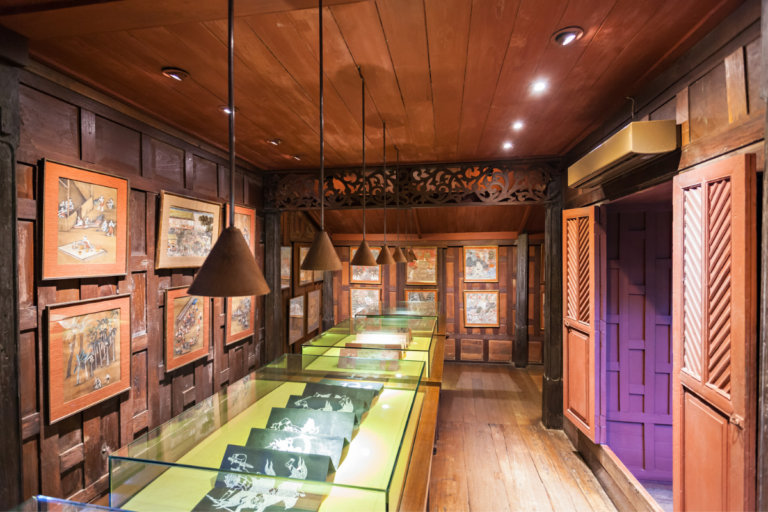Thai Silk
World-famous Thai silk is made from an ancient art form that received a breath of new life after World War II when an American man named Jim Thompson started exporting the product worldwide. Before that, Thailand did not manufacture silk and imported it from other countries. During the late 1940s, Jim Thompson made a savvy investment in silk production that changed the game, with his products appearing in the pages of Vogue and even making their debut in the Broadway show, The King and I. His impact is still felt today, with the Jim Thompson House Museum remaining one of Bangkok’s most popular attractions.
Thai silk has been industrialized to the extent that a majority of the fabric is manufactured in bulk in huge textiles. All across the tourist areas of Thailand, you’ll find silk shopping products, ranging from well-tailored garments to pillows and handbags, in boutiques and shops.
 Despite modernization, there’s still a demand for handmade silk in the old fashion, most of which comes from Isaan in the northeast of Thailand. Here you can still find smaller producers who practice the old hands-on method with silk, giving silk shopping fans in Thailand access to some of the finest quality fabric in the world.
Despite modernization, there’s still a demand for handmade silk in the old fashion, most of which comes from Isaan in the northeast of Thailand. Here you can still find smaller producers who practice the old hands-on method with silk, giving silk shopping fans in Thailand access to some of the finest quality fabric in the world.
While it’s safe to say that most of the nation’s silk is produced in the northern provinces, where mulberry trees (the silkworm’s favorite food) are cultivated, you’ll still find a handful of silk producers as far south as Bangkok with greater access to the flux of tourism shopping dollars. The silk is cultivated and refined in the Korat plateau area but much of the intricate dyeing and weaving takes place in the handicraft centers near Chiang Mai.
Types of Thai Silk
Thai silk has a distinct label to ensure its authenticity, which is a peacock emblem issued by the Agriculture Ministry of Thailand. It has a few types:
- Gold peacock
- Silver peacock
- Blue peacock
- Green peacock
The peacock emblem indicating Royal Thai Silk (gold), Classic Thai Silk (silver), Thai Silk (blue), and Thai Silk Blend (green) helps distinguish between different types of Thai silk. While premium Royal Thai Silk is made of native Thai silkworm breeds with traditional hand-made production, Classic Thai Silk is made from specific silkworm breeds with hand-made production. Thai Silk is made of pure silk threads and allows chemical dyes, whereas Thai Silk Blend is a blend of silk with other fabrics and allows no specific production method.
Where to Look for Thai Silk
Bangkok
Surawong Road, home to Jim Thompson’s business, is the best location when shopping for silk in Bangkok. Jim Thompson offers a variety of opulent silk items, from fabric to scarves to shirts, along with other accessories like bags and ties. Their trendy designs are particularly desirable for those with a taste for high-end fashion. Considering their quality, however, the Thai silk at Jim Thompson comes at a cost. Jim Thompson Thai silk scarf prices start at 4,000 THB.
Find them at 149/4-6 Surawong Road, Bang Rak, Bangkok 10500, Thailand. They are open daily from 12 pm to 10 pm.
There are a few other reliable vendors for purchasing Thai silk, such as Queen Thai Silk, shopping malls like the MBK Center, and even the Chatuchak Weekend Market if you’re not concerned about the material being synthetic. For a more authentic experience, travelers can check out family-owned farms producing their own silk in the north of Thailand.
Chiang Mai
The San Kamphaeng district of Chiang Mai is another silk shopping paradise with a variety of styles and colors. Former Prime Minister Thaksin Shinawatra’s family even runs a silk business here.
Phuket
There are plenty of places in Phuket where you can find high-quality Thai silk.
In Phuket, you’ll find several boutiques in Patong and Kata as well as silk products in hotel gift shops. Similar options are found in Samui’s Chaweng district and duty-free shops at international airports. Some popular options include the Jim Thompson store in Phuket, known for its beautiful textiles and traditional patterns, and Baan Batik, which offers a unique spin on traditional silk with its hand-dyed batik designs. If you’re looking for a more authentic experience, head over to Phuket Old Town for a variety of local shops and street vendors selling handcrafted silk goods.
Annual Silk Fair
One of the most entertaining times for shopping for silk is near the year’s end in Khon Kaen, a city that hosts an annual silk fair. Crowds of tourists and Thais alike flock to the city to get in on the trading, and you’re likely to see more varieties of silk at one time here than anywhere else in the country.
Exporters frequent the busier, high-volume dealers (like those found in Bangkok or Chiang Mai’s San Kamphaeng district) to purchase silk wholesale and export it to their own countries. Smaller boutique shops sell handmade garments made from silk, or you pick up some fabric yourself and get fitted by a local tailor in order to have your own garment made.
What Makes Thai Silk Special
Thai silk takes on brighter hues and colors than its counterparts in other parts of the world. This is due, in part, to its coarsely woven fibers and which are easier to dye than other types of smoother silk. This also results in a unique sheen that can only be found in Thai silk. When shopping you’ll discover there are also particular traditional patterns distinctive to Thailand. It’s worth knowing that there are different grades and textures of silk, ranging from soft satin-like grades to coarser weaves (complete with little strand join ‘nodes’) more suitable for smart tunics.
How to Recognise Real Thai Silk
Silk suppliers offer a staggering variety of bright colors, varied patterns, and traditional silk tapestries, all of which are graded according to their quality. While shopping for silk in Thailand, watch out for imitation ‘Chinese’ silk, which is considerably cheaper but is notoriously inferior to true Thai silk. Synthetic silk looks good but is no substitute for real material. It’s lighter, and less breathable but much cheaper. Ultimately it lacks the signature ‘two-tone’ of real silk.
At most tourist markets or souvenir shops, the so-called “Thai Silk” on offer is often inauthentic. Despite the sewn label proclaiming to be 100% Thai silk, the fabric’s actual makeup is 100% polyester.
There are various ways to recognize genuine silkworm silk in a product.
Burning Test
One of the obvious methods is by burning it, as real silk burns like hair and produces a noxious smell, while artificial silk creates a plastic-like crab that continues to burn. But, burning a 2,000 baht silk outfit may not be a wise idea.
Sheen Test
Another way is the sheen test, a widely used technique, in which authentic silk displays a two-tone appearance as the garment moves in light due to the use of two different shades in the warp and weft on the loom. Furthermore, another method is to watch out for imperfections; real silk possesses thread breaks that result in tiny bumps in the fabric, while Chinese silk uses a single long continuous strand.
Price Test
Thai silk isn’t a product that can be bargained over; instead, pricing is reasonable and rooted in fairness. It can cost anywhere from 100 USD (3,500 THB) for a 1.5-meter bolt of mudmee silk, and up to 3,000 USD (100,000 THB) for the highest quality, brocaded silk. Don’t expect to find a bolt of real Thai silk for just 300 THB.
Thai Silk in Numbers
According to the Department of Sericulture, in 2013, about 71,630 traditional farmers cultivated mulberry silkworms, and the mulberry plantations covered 39,570 rai. They managed to produce around 287,771 kilograms of mulberry silk. The industrial production of mulberry cocoons covered 15,520 rai of mulberry plantations, with 2,552 farmers involved, generating roughly 145,072kg of silk.
On the contrary, Eri silk production constitutes only a fraction of these amounts, raised by a small network of 600 families dispersed throughout 28 provinces in northern, northeastern, and central Thailand.



